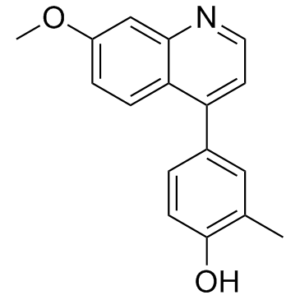CU-CPT-9a
This product is for research use only, not for human use. We do not sell to patients.

For small sizes, please check our retail website as below: www.invivochem.com
| Size | Price | Stock |
|---|---|---|
| 250mg | $1550 | Check With Us |
| 500mg | $2350 | Check With Us |
| 1g | $3525 | Check With Us |
Cat #: V3816 CAS #: 2165340-32-7 Purity ≥ 98%
Description: CU-CPT-9a, an analog of CU-CPT-8m, is a potent and specific antagonist/inhibitor of TLR8 (Toll-like receptor 8) (IC50 = 0.5 nM) with the potential to be used for treating autoimmune diseases.
Top Publications Citing Invivochem Products
Publications Citing InvivoChem Products
Product Promise

- Physicochemical and Storage Information
- Protocol
- Related Biological Data
- Stock Solution Preparation
- Quality Control Documentation
| Molecular Weight (MW) | 265.31 |
|---|---|
| Molecular Formula | C17H15NO2 |
| CAS No. | 2165340-32-7 |
| Storage | -20℃ for 3 years in powder formr |
| -80℃ for 2 years in solvent | |
| Solubility In Vitro | DMSO: >30 mg/mLr |
| Water:<1 mg/mLr | |
| Ethanol: <1 mg/mL | |
| SMILES Code | OC1=CC=C(C2=CC=NC3=CC(OC)=CC=C23)C=C1C |
| Synonyms | CU-CPT9a; CUCPT9a; CU CPT9a |
| Protocol | In Vitro | CU-CPT-9a is a specific TLR8 antagonist, with an IC50 of 0.5±0.1 nM. The elevation of the downstream protein levels induced by R848 can be reversed by CU-CPT-9a in a dose-dependent manner. By contrast, the expression of TRIF and IRF3 (cytoplasmic and nuclear) are only responsive to TLR4 and TLR3, independent of TLR837. The expression levels of TRIF and IRF3 do not show significant change in THP-1 cells upon treatment of R848, nor do they change with the treatment of CU-CPT-9a. CU-CPT8m and CU-CPT-9a both significantly suppress the TNF-α level in a dose-dependent manner, which is in agreement with previous reports of TLR8 involvement in these autoimmune diseases. |
|---|
These protocols are for reference only. InvivoChem does not
independently validate these methods.
| Solvent volume to be added | Mass (the weight of a compound) | |||
|---|---|---|---|---|
| Mother liquor concentration | 1mg | 5mg | 10mg | 20mg |
| 1mM | 3.7692 mL | 18.8459 mL | 37.6918 mL | 75.3835 mL |
| 5mM | 0.7538 mL | 3.7692 mL | 7.5384 mL | 15.0767 mL |
| 10mM | 0.3769 mL | 1.8846 mL | 3.7692 mL | 7.5384 mL |
| 20mM | 0.1885 mL | 0.9423 mL | 1.8846 mL | 3.7692 mL |
The molarity calculator equation
Mass(g) = Concentration(mol/L) × Volume(L) × Molecular Weight(g/mol)
Mass
=
Concentration
×
Volume
×
Molecular Weight*
The dilution calculator equation
Concentration(start)
×
Volume(start)
=
Concentration(final)
×
Volume(final)
This equation is commonly abbreviated as: C1 V1 = C2 V2
Concentration(start)
C1
×
Volume(start)
V1
=
Concentration(final)
C2
×
Volume(final)
V2
Step One: Enter information below
Dosage mg/kg
Average weight of animals g
Dosing volume per animal µL
Number of animals
Step Two: Enter the in vivo formulation
%DMSO
+
%
+
%Tween 80
+
%ddH2O
Calculation Results:
Working concentration:
mg/ml;
Method for preparing DMSO master liquid:
mg
drug pre-dissolved in
µL
DMSO(Master liquid concentration
mg/mL)
,Please contact us first if the concentration exceeds the DMSO solubility of the batch of drug.
Method for preparing in vivo formulation:
Take
µL
DMSO master liquid, next add
µL
PEG300, mix and clarify, next add
µL
Tween 80,mix and clarify, next add
µL
ddH2O,mix and clarify.
Note:
- (1) Please be sure that the solution is clear before the addition of next solvent. Dissolution methods like vortex, ultrasound or warming and heat may be used to aid dissolving.
- (2) Be sure to add the solvent(s) in order.




































